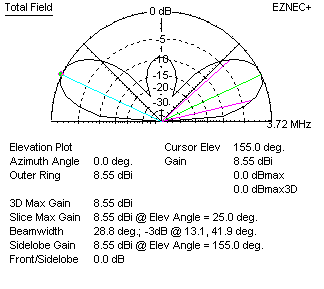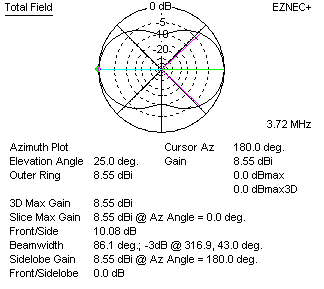Antennas for Receiving and Transmitting
[ Home ]
[ Combiner and Splitters ]
[ Common mode current ]
[ G5RV Antenna ]
[Inductors and Loading Coil Current (Mobile and Coil Loaded Antennas) ]
[ Rhombic Antennas, V-beam, and Inverted V ]
[ Short dipoles and problems ]
[ 5/8th wave mobile antenna vs 1/4 wave ]
[ end fed 1/2 wave matching system end feed ]
[ Folded Dipole ]
End fed longwire or
random wire antenna
To view a few of
my antennas and
station, look at
MY
STATION
Warning about
antenna models!
The dipole is the
basic building block
of many antennas.
A dipole does NOT
have 2.2 dB gain over
an isotropic
radiator when the
dipole is placed
over earth. The
dipole has
about 8.5 dB gain
over an isotropic
radiator! Always
remember this when
you see antenna
models over earth
given in dBi. If the
model over earth
shows a “gain” of
about 8.5
dBi, the model
effectively has the
same gain as a
dipole.
Here is the
pattern of a 145-foot high copper wire dipole over medium real earth on EZNEC:


You can see the
gain is
8.5 dBi, and
it is just a simple
dipole just over 1/2
wave high. Any
antenna you model
should always be
compared to a
standard like this!
The notion a dipole has around 2.15 dBi gain is only true for freespace.
Multiple
Articles at:
Receiving:
Contains
information in many
articles. Receiving
antennas including
Beverages and
Beverage Antenna
Construction, Loops,
K9AY, Pennant, Flag,
EWE, Slinky Beverage
Antennas, vertical
arrays, magnetic
loop antenna, and
terminated loop
arrays.
Transmitting:
Pictures of some
transmitting
antennas at my
station. Most
transmitting
antennas link from
the top of this
page.
Single articles:
Balun
and Core Selection:
Contains information
on core selection
for transformers and
baluns
Baluns,
Sleeve balun:
How they work
Baluns,
transmitting: What
they do, how they do
it, and how to test
them
Balun,
Toroid:
Winding style,
debunking
split-winding will
improve
performance
Crossfire
Phasing: Contains
information on cross
fire phasing and why
it is superior for
broad bandwidth
arrays
Combiner
and Splitters:
Contains information
on Magic-T splitters
and combiners, how
they work and what
they do
Curtain Arrays:
USIA and Distributed
Feed Curtains,
Sterba Curtains,
Lazy H antennas and
other curtain
antennas
Detuning
Towers: A
quick explanation of
how it works and the
incorrect idea that
you adjust for
minimum current!
Pass this along, it
is a major error to
tune for minimum
current!
EH
antenna: the
E-H and CFA
antennas. How they
work.
Inductors,
Loading: A
brief tutorial on
loading inductors
Mobile
and Loaded Antennas:
Small loaded antenna
systems
(Related page: Inductor
spice model)
Short
Antennas and
feed line loss:
Remember to include
feed line losses in
models
Omega
and Gamma Matching:
Contains technical
information on Omega
and Gamma matches
and matching,
impedance limits,
component selection,
component
failures
Radiation
and Fields:
What the terms we
use actually
describe
Radiation
Resistance:
A revised (as of Feb
14, 03) tutorial on
radiation resistance
and how it is used
and misused
Rohn Tower:
How we installed
various Rohn towers by
lifting with a crane
Rohn 65G:
How we built a gin
pole or erection
fixture for Rohn 65G,
and the final result
Rhombic antennas:
Models and theory of
a rhombic antenna
Traps:
Measurements and
operation of
traps and trap
antennas. Including
trap antenna loss.
since
May 2004
©2003,2004 W8JI